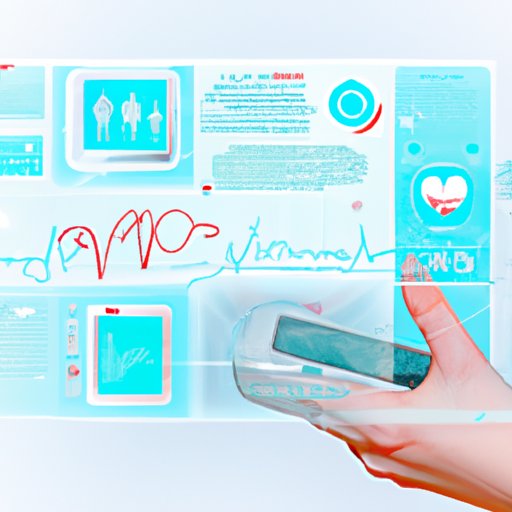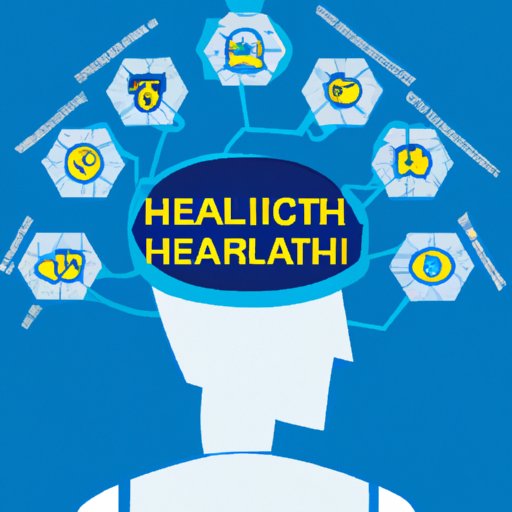Introduction
Technology has revolutionized virtually every aspect of our lives, from communication to entertainment, education to transportation. In recent years, technological advances have also had a profound effect on the healthcare industry. While technology has brought many benefits in terms of diagnosis and treatment, it has also presented challenges for healthcare providers and patients alike. In this article, we will explore how technology affects health and well-being, as well as the risks and benefits associated with its use.
Exploring the Pros and Cons of Technology on Health
The use of technology in healthcare is growing rapidly, and with it comes both advantages and disadvantages. Let’s look at some of the most common pros and cons of technology in healthcare.
Benefits of Technology in Healthcare
One of the primary benefits of technology in healthcare is improved accuracy. With the use of electronic medical records (EMRs), doctors can access patient data quickly and accurately, which can lead to more accurate diagnoses and better quality of care. Additionally, EMRs allow healthcare providers to share information between different departments and hospitals, resulting in faster treatment times and improved patient outcomes.
Another advantage of technology in healthcare is increased efficiency. By automating certain processes, such as scheduling appointments or ordering prescriptions, healthcare providers are able to save time and resources, which can result in cost savings for both the provider and the patient.
Challenges of Technology in Healthcare
While there are many benefits to technology in healthcare, there are also some drawbacks. One of the primary challenges is the risk of privacy and security breaches. As healthcare providers move to digital systems, they must take extra measures to ensure patient information is kept secure. Additionally, the cost of implementing and maintaining new technologies can be prohibitive for some healthcare providers.
Another challenge of technology in healthcare is that it can be difficult to keep up with the rapid pace of change. New technologies are being developed all the time, and healthcare providers must stay informed about the latest advancements in order to provide the best possible care for their patients.

Evaluating the Impact of Technology on Mental Health
In addition to its physical benefits, technology can also have a positive impact on mental health. Let’s look at some of the advantages and disadvantages of using technology in mental health care.
Advantages of Technology in Mental Health Care
One of the primary benefits of technology in mental health care is increased access to care. With telemedicine, patients can receive mental health services from the comfort of their own homes, removing the barrier of having to travel to a doctor’s office. Additionally, mobile apps and online therapy can make it easier for people to access mental health services, even if they don’t have access to traditional forms of care.
Another advantage of technology in mental health care is improved accuracy. With the use of artificial intelligence and machine learning, mental health providers can analyze large amounts of data to identify patterns and uncover insights that may not have been apparent before. This can help providers determine the best course of treatment for their patients.
Disadvantages of Technology in Mental Health Care
While there are many advantages to using technology in mental health care, there are also some potential disadvantages. One of the primary concerns is the risk of privacy and security breaches. As with any digital system, it’s important to ensure that patient information is kept secure and confidential.
Another potential downside is the lack of human connection. While technology can be a useful tool for delivering mental health services, it cannot replace the value of face-to-face interactions with a therapist or other mental health professional.
Examining How Technology is Changing the Healthcare System
The use of technology in healthcare is changing the way healthcare is delivered. Let’s look at some of the ways technology is transforming the healthcare industry.
Automation and Artificial Intelligence
Automation and artificial intelligence (AI) are playing an increasingly important role in healthcare. AI can be used to automate administrative tasks, such as scheduling appointments or processing insurance claims. Additionally, AI can be used to analyze large amounts of data to uncover patterns and insights that can help healthcare providers improve patient care.
Telemedicine
Telemedicine is the use of technology to deliver healthcare services remotely. Telemedicine can be used to diagnose and treat a variety of conditions, from minor illnesses to more serious conditions. Additionally, telemedicine can be used to provide mental health services, such as counseling or therapy.
Wearable Technology
Wearable technology is becoming increasingly popular in the healthcare industry. Smartwatches and fitness trackers can be used to monitor vital signs and activity levels, providing valuable data to healthcare providers. Additionally, wearable devices can be used to remind patients to take their medications or provide notifications when something is out of range.

Investigating the Role of Technology in Preventive Care
In addition to its role in diagnosis and treatment, technology can also play an important role in preventive care. Here are some of the ways technology can be used to promote good health and prevent illness.
Personalized Medicine
Personalized medicine is the use of technology to tailor treatments to an individual’s unique genetic makeup. By analyzing a person’s genetic data, healthcare providers can develop personalized treatments that are more effective and less likely to cause side effects.
Predictive Analytics
Predictive analytics is the use of data and algorithms to predict future events. In healthcare, predictive analytics can be used to identify individuals who are at risk for certain conditions, allowing healthcare providers to intervene before the condition develops.
Remote Monitoring
Remote monitoring is the use of technology to monitor a patient’s health from a distance. By using sensors and other tracking devices, healthcare providers can monitor a patient’s vital signs and activity levels without the need for in-person visits.

Assessing the Risks and Benefits of Wearable Technology for Health
Wearable technology can be a powerful tool for improving health and wellness, but it also comes with some risks. Let’s look at some of the potential risks and benefits of using wearable technology for health.
Privacy and Security Concerns
As with any digital system, there is a risk of privacy and security breaches when using wearable technology. It’s important to ensure that any data collected by wearables is kept secure and only shared with authorized personnel.
Accuracy of Data
Another potential concern with wearable technology is the accuracy of the data it collects. While most wearables are designed to be accurate, there is always the possibility of errors or inaccuracies. It’s important to verify the accuracy of any data collected by wearables before making decisions based on it.
Conclusion
Technology has revolutionized the healthcare industry, bringing both benefits and challenges. On the one hand, technology can improve accuracy, reduce costs, and increase access to care. On the other hand, there are risks associated with the use of technology in healthcare, such as privacy and security concerns, as well as accuracy issues with wearable devices. Ultimately, the use of technology in healthcare should be carefully evaluated to ensure that the potential benefits outweigh the potential risks.
In conclusion, technology has had a profound effect on health and well-being. While there are risks associated with its use, the potential benefits far outweigh them. With careful evaluation and implementation, technology can be used to improve healthcare and promote good health.
(Note: Is this article not meeting your expectations? Do you have knowledge or insights to share? Unlock new opportunities and expand your reach by joining our authors team. Click Registration to join us and share your expertise with our readers.)
